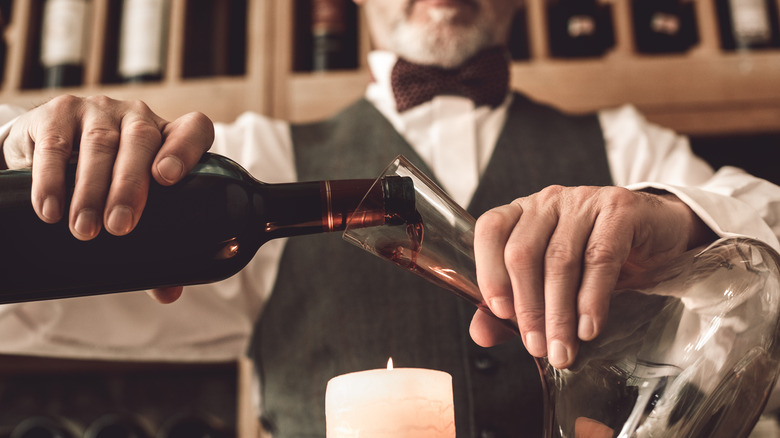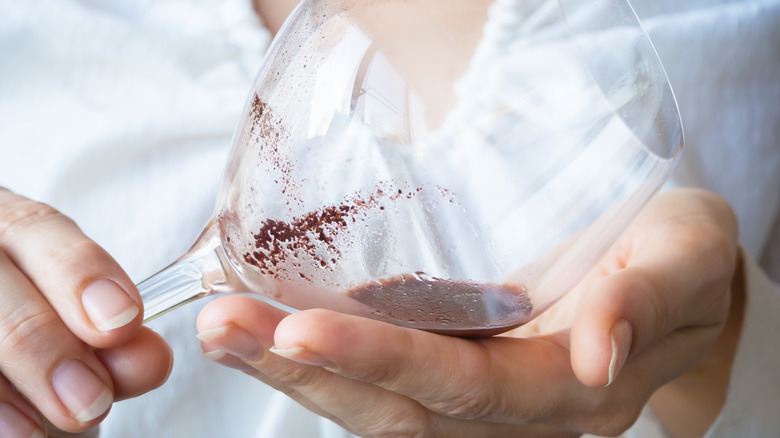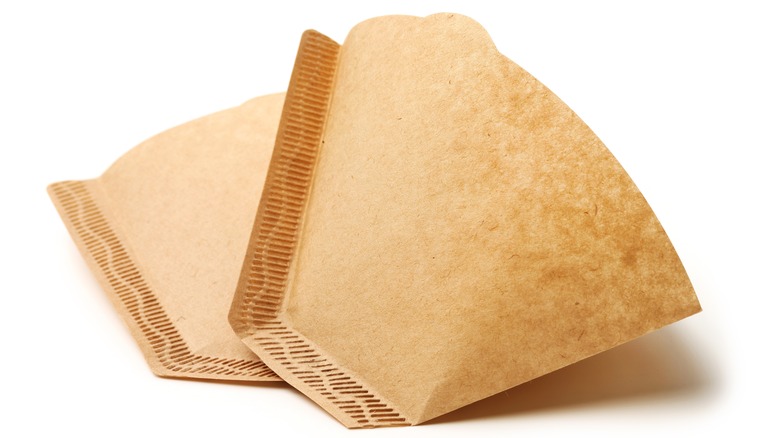Why Sommeliers Use Candles To Test Wine
Lees and wine diamonds. Those two terms sound more like the baubles in a Tiffany's jewelry store than what they actually are: sediments in wines. Fortunately, sommeliers have an enlightening solution — literally — for dealing with these deposits. You probably already have a few of their key tools in your kitchen's emergency drawers, right next to your $10 wine corkscrew: candles. A strategically positioned candle below the neck of the bottle gives the sommelier a bird's eye view of any sediment still in the wine. The idea is simple. Once the wine steward spots the sediment in the neck of the bottle, it's time to stop pouring the wine. The candle lights up the bottle's interior just enough to give the sommelier a good peek at the bits of stems, seeds, skins, and other matter that are still left in the bottle before they hit the bottom of your glass.
However, wine decanting doesn't have to be quite so chi chi if you're drinking at home without the benefit of a trained sommelier. If you don't have a candle, the light from your iPhone or the flashlight in the junk drawer will do just fine. As long as you have enough light to see the wine debris in the wine, that's all that matters. As a bonus, these illumination methods don't leave behind a smokey trail like a candle might. The scent of smoke ruins the taste of even the best wine faster than the sludge will detract from your enjoyment of Bacchus' sacred juice.
What exactly are lees and wine diamonds?
So what are these two types of deposits found in your favorite drink? Well, when white wines go through the fermentation process, they leave behind tartrate crystals, or more colloquially, the wine diamonds. These resemble small bits of glass, but they're actually the basis for what bakers know as cream of tartar, or for the sommeliers in the crowd, potassium bitartrate. Because white wine is chilled, the conditions in the wine are ripe for the development of wine diamonds.
Winemakers sometimes use stabilization methods to prevent wine diamonds. A three-week stint in temperatures below 32 degrees Fahrenheit leaves the cream of tartar starter mix to collect at the bottom of the barrel, or the tank, in this case. At the end of such time, savvy bakers can come along and sweep up this gem of baking, should they be so inclined.
As for the lees, that's the yeast after it's given its all to make that primo bottle of wine. The yeast goes on a feeding frenzy of sorts, consuming all the sugar it can find in the grape juice. Left in the wake of the yeast's feast are carbon dioxide, and of course, the gold of the equation, the alcohol. The lees have a few distinctions, called "gross lees" and "fine lees." The gross lees get taken out of the mix early on. The fine lees are the bodies of the deceased yeast cells, which, despite the sounds of it, helps the liquid age like the fine wine it's supposed to be.
Ways to deal with wine sediment
It isn't always possible to have a wine steward at your disposal, but that doesn't mean you can't bring the wisdom of the sommelier to your next uncorking session. You don't even need a candle to stop the wine sludge from depositing itself in the bottom of your wine glass. Pouring your wine into a decanter onto which you've fastened a muslin cloth, a coffee filter, or even a strainer with small holes serves the same purpose. These items create a barrier between the wine sediment and your wine glass, leaving you with grit-free, wine-drinking bliss.
There are also steps to take before you open a bottle of wine. Wine sludge settles wherever gravity takes it. If an unopened bottle of wine is stored on its side for long periods of time, you'll see a line of sediment from the bottom to the lip of the bottle. This is a result of gravity doing its thing, but you can harness the Big G's pulling power so that it works for you here. A couple of days before you serve the wine, stand the bottle upright. The sediment will get pulled down to the bottom of the bottle. While some sludge may still make its way to the higher parts of the bottle, standing the bottle up slows the process down. Finally, if a bit of sediment does end up in your wine glass, don't fret. It's yucky to think about but otherwise harmless.


